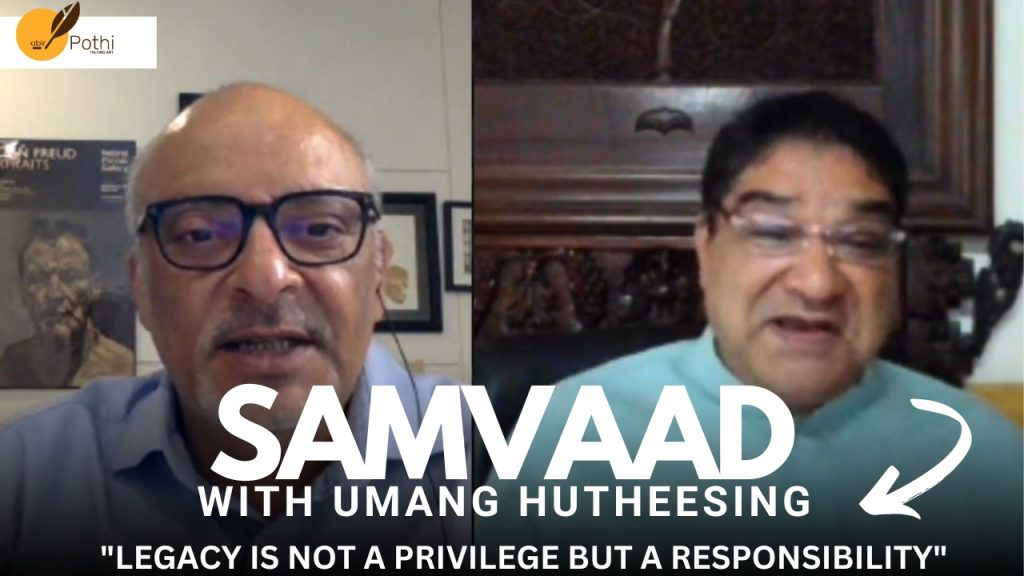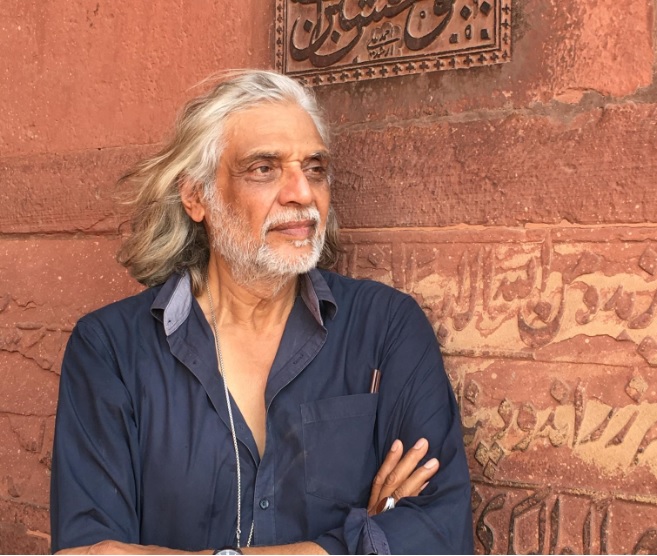Welcome to Samvaad, where art meets conversation, and inspiration knows no bounds. Here we engage in insightful conversations with eminent personalities from the art fraternity. Through Samvaad, Abir Pothi aims to create a platform for thought-provoking discussions, providing readers with an exclusive glimpse into the creative processes, inspirations, and experiences of these creative individuals. From curating groundbreaking exhibitions to pushing the boundaries of artistic expression, our interviews shed light on the diverse perspectives and contributions of these art luminaries. Samvaad is your ticket to connect with the visionaries who breathe life into the art world, offering unique insights and behind-the-scenes glimpses into their fascinating journeys.
This is part 4 of the Samvaad between Nidheesh Tyagi from Abir and Umang Hutheesing, the founder and president of the Hutheesing heritage foundation. Umang Hutheesing is on the governing board of the Ahmedabad Education Society, a managing trustee of the Hutheesing Visual Art Centre, and most importantly is the president and fifth generation of Hutheesing to manage the Hutheesing Design Company and Studio from the very same historic location, Jaising bhai-ni-wadi. He is also the founder and president of the Hutheesing heritage foundation which has restored the Hutheesing Haveli and preserves the Hutheesing art collection. He has collaborated with the international foundation Musée Yves Saint Laurent in Paris and the National Museum of Bahrain, the Baroque Museum in Mexico, the Miho Museum in Japan, and the Chhatrapati Shivaji Vaastu Sangrahalya in Mumbai, where he has exhibited over 300 pieces showcasing the cultural heritage designed by him from the Hutheesing collection.
Nidheesh: I would first ask about the forty-five years of your visual arts centre because that is something in itself is a great journey, and you’ve been part of this majorly. Art has changed throughout these years, and you’ve seen art in your own family even before your exposure to art in India, Hussain Sahab, and others. So, if you can take us through your journey. This is a celebrity kind of moment for the visual art centre, and it’s a great journey.
Umang: So, the visual art centre was built by Doshi. But it has so many institutes, for example, Hussain Doshi Gufa is also made next to us. It was designed by them, but it is on our land. The first solo exhibition of M.F. Hussain was done by Hutheesing art centre, the gallery opened with Hussain shows, Raza shows even the progressive artists group.
Nidheesh: all these were there.
Umang: Many of them used to come here, to do work. So I’ve seen that from my childhood. In fact, when the centre opened at the opening event, there was a play on Gandhari from Mahabharata. There were two sets on the main campus and the background of both of them were painted eight feet by twelve feet or fifteen feet painted by M.F. Hussain. The sets were made by M.F. Hussain. We have buildings by M.F. Hussain. And that’s how we started. He was doing posters for films and doing sets for us at that time, and then we did his first solo exhibition and the rest is history. Similarly, the Santiniketan was done by Hatheesing’s support, Hutheesing Tagore Trust and that is also history.
Nidheesh: these are not chapters, these are like the whole book itself in my mind.
Umang: yes. Each one. Nandlal Bose did fantastic paintings of Ajanta. The entire Ajanta collection is with us including the vases made by Nand Lal Bose. We have got 40 vases painted by Nand Lal Bose, which you will not see anywhere, not even at Kala Bhawan. What we took for granted after coming back from America, you know, you started, of course, you are mature, and you started viewing this understanding from a different perspective.
Nidheesh: True
Umang: Gagendranath Tagore’s work, getting people to understand the British atrocities but yet to be done very subtly. You know you have to understand that at times also, those times what did they do, how did they get around to, you know art is also a reflection of society and time. Picasso’s paintings became famous after the civil war in Spain. So, similarly, you’re talking about the Indian revolution and painting and art at that time is very different art today in modern India and which is a powerful economy. So you know we have to see all these in perspective of time.
Nidheesh: true. And what was the context of doing one thing over the other?
Umang: either it is Kalighat paintings or maybe Pat Chitras, they’re also very important to me. See, I’ve also observed one thing, world to world. When a country, I mean in the last two hundred years Europe ruled the world, not 200 but 2000. Therefore, whatever they considered beautiful was art. There’s one more thing called native things, it’s a country of 1.4 billion people, we’re not native, and our architecture is not vernacular, it’s classical and traditional. We’re getting rid of those words, vernacular, ethnicity, I mean bullshit. That’s what the British called us because they ruled us. You know Rishi Sunak doesn’t call King Charles a native king.
Nidheesh: so much of it is so older than they have been. If you go south you’ll find amazing temple architecture and the forts in Rajasthan.
Umang: of course, I mean as a nation grows economically and by its education and larger vision, it becomes more confident, its people. And then they become proud owners and custodians of that culture and that through arts that is the reflection of a nation. Why did progressive artist group create? Their hero was Picasso because Europe celebrated Picasso, and they wanted to be progressive. So it could not be from India where you’re all rooted. So, I mean if we don’t understand these things, we will get confused.
Nidheesh: I think it’s also very helpful to be an insider from the outside, so you see the other world and come back then probably..
Umang: we don’t teach art history in our schools. In India, which is contemporary art started by Picasso, and that’s where the progressive artists’ group started. Young artists don’t know what Picasso thinks of cubism that they don’t know. So, we have many artists doing abstract things with no origin, it is an indirect subconscious imitation of something that they have seen but can not explain.
Nidheesh: another thing is, one question I was asking Jaitley the other day, and we were talking about how crafts, I mean especially because you work with textile as well, and also you deal with this the art thing and craft, in between the artisans and the design people, I also translated T.M Krishna’s book on Sebastian and Sons, which about the people who play Mridang and who make Mridang, so the art and craft again. So this is a very complex kind of a relationship, and you’re somewhere between in it these two, the artisans and the craft thing..
Umang: and I do paint as well.
Nidheesh: yeah. Of course. But, I was saying that primarily you as a design person with huge things in textile so that’s why this question is coming out.
Umang: definitely, you know if you ask most young people who are the current head of ISRO who is one of the most important engineers or scientists, and they largely contributed to our growth and well-being, who invented the vaccine they won’t know. But when you ask about the b grade TV star or a c grade designer, they would know. Because we’re glorifying the wrong things.
Nidheesh: true
Umang: media glorifies the wrong things and the youth wraps it up. There was a time, say fifty years ago, when every young child wanted to be an engineer and doctor to join the government services. Today’s youngsters aspire to be Indian Idol.
Nidheesh: yes, they want to be influencers on the internet.
Umang: exactly, influence who and what?
(Both laughs)
Umang: I am not downgrading them, I am just trying to understand it. My learning capacities are limited, I am an old person from an old school.
Nidheesh: no, you are not. Come on.
(Both laughs)
Samvaad: Conversations with Umang Hutheesing (Part III of VI)





